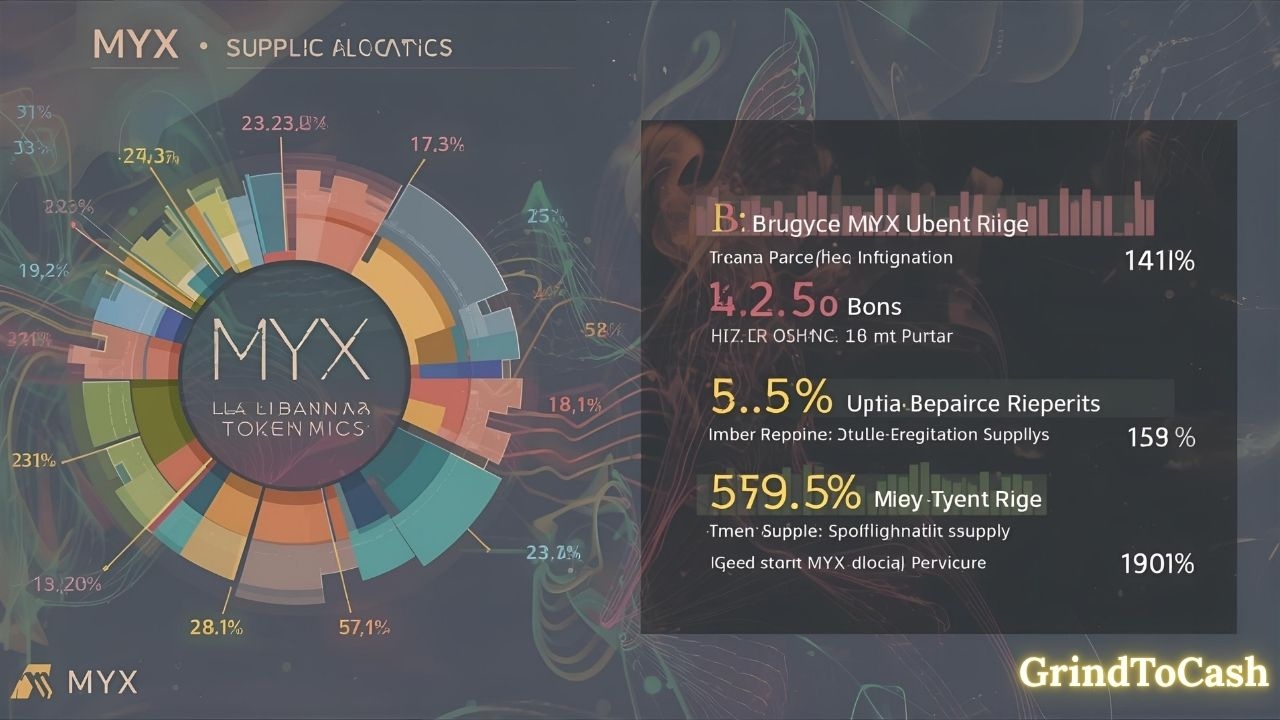The Complete MYX Finance Token Growth & Analysis in 2025
MYX Finance is a decentralized derivatives exchange built to offer low-slippage perpetuals, cross-chain access, and a protocol token (MYX) designed for governance and ecosystem incentives. Below we break down what MYX does, how its tokenomics work, where to buy it, and the risks investors must watch. For readers of GrindToCash this is a practical, step-by-step overview you can use right away.
By Yaser | Published on October 3, 2025

What MYX Finance Is and Why It Matters
MYX Finance is a decentralized perpetuals DEX aimed at giving traders CEX-like execution while keeping permissionless access and composability. The protocol uses a unique liquidity and matching model that reduces slippage for large orders and supports multi-chain trading. This matters because derivatives are a major market in crypto — if MYX can combine low costs, deep liquidity, and cross-chain access, it could attract serious traders and liquidity providers. For anyone tracking DeFi infrastructure, MYX represents an example of building derivatives with on-chain design tradeoffs in mind.
The product idea in one sentence
MYX tries to merge the best of centralized exchanges (tight execution, deep liquidity) with DeFi features (composability, on-chain settlement). The goal is to let traders open leveraged positions without the usual DEX slippage penalties. That combination broadens use cases and can increase on-chain volume if executed well.
Who uses MYX today (typical users)
Traders who want low slippage on perpetuals, arbitrage bots that exploit cross-chain differences, and LPs looking for fee income and protocol incentives are typical. Institutional or high-frequency users may also be attracted if US liquidity and execution quality remain strong.
Why you should pay attention now
Derivatives capture a lot of crypto volume. If MYX continues to add pairs and integrations, its network effects could grow quickly. For investors, early understanding helps you size positions and spot both traction and potential product risk early.

Short History, Launch & Funding Context
MYX held public distribution events and raised institutional capital during its launch phase, which helped provide initial liquidity and marketing. Funding and IDO details show that MYX attracted early backers and exchange support, which jump-starts listings and volume. That early capital also funds developer growth and ecosystem incentives. However, funding size and public sale share affect future unlocks and circulating supply, so they are essential numbers to check before investing. For transparency, always read the protocol’s fundraising and vesting pages.
What the initial raise means for supply pressure
Large institutional allocations or short lockups can lead to unlock events that increase circulating supply. This may create price pressure at certain dates, so map those dates and compare them to product milestones.
Exchange support at launch
Early exchange support (listings and trading pairs) helps price discovery and liquidity. MYX’s early presence on major platforms accelerated access for global traders and improved market depth.
Why funding sources matter for trust
Who invested and how tokens were allocated signals confidence or centralization risk. Reputable institutional backers and clear vesting schedules are positive signs; opaque funding is a red flag.

Tokenomics: Supply, Allocation & Emission Rules
MYX has a total supply of 1,000,000,000 tokens and a clear allocation split across ecosystem/community, institutional investors, team/advisors, initial liquidity, and reserves. The largest bucket typically supports ecosystem growth and rewards, while team and institutional allocations are subject to vesting. These allocation ratios matter because they determine future unlocks and how much supply can flow to the market. Always check the tokenomics page and on-chain contract to confirm percentages and vesting timelines before you invest.
Community & ecosystem allocation explained
A large community allocation is positive when it’s used for liquidity incentives, user rewards, and grants. It can help adoption but must be managed transparently to avoid future dumps.
Team and investor allocations: vesting matters
Team and investor tokens should be locked with sensible cliffs and gradual releases. Short or missing lockups increase dump risk. Favor projects with public vesting schedules and multisig controls.
Emission schedule and inflation effects
New token emissions for rewards increase circulating supply over time and can dilute holders unless offset by demand or token sinks (burns, protocol fees). Model expected emissions against likely demand to judge sustainability.

The Tech: Matching Models, Liquidity, and Chains
MYX differentiates itself with a matching liquidity design intended to reduce slippage, sometimes described as a peer-to-pool-to-peer or matching pool mechanism. The protocol architecture emphasizes cross-chain accessibility and low execution costs. For developers and advanced users, the tech choices determine integrations, latency, and composability. For traders, they determine execution quality and fees. When evaluating protocol claims, review the whitepaper, audits, and testnet/mainnet performance metrics.
How the matching mechanism helps traders
A well-designed matching layer can route orders internally to avoid large pool price impact, lowering effective slippage for big trades and improving fills for users.
Cross-chain plumbing and bridge dependence
Cross-chain features add utility but also bridge-risk. Check which bridging solutions the protocol uses and whether they rely on trusted validators or on decentralized security.
Audits, code transparency and developer tools
Open audits, public repos, and accessible SDKs increase trust and speed integration. Lack of audits or closed code raises risk for users and integrators.

Use Cases, Token Utility & On-Protocol Benefits
The MYX token is typically used for governance, fee discounts, staking, and reward distribution within the protocol. Utility tokens that capture protocol revenue, reward active LPs or secure governance tend to have stronger demand hooks. MYX’s utility design aims to create multiple demand pathways — trading fee capture, staking incentives, and ecosystem grants — which can help token value if adoption grows. Still, utility is only as valuable as real product activity and fee revenue.
Governance and voting power
Governance tokens let holders propose and vote on protocol changes. Active on-chain governance can improve decentralization but also requires engaged communities to work well.
Staking and rewards mechanics
Staking programs lock tokens, which reduces circulating supply temporarily and rewards long-term holders. Look at unstake delays, slashing rules, and reward rates.
Fee capture and token sinks
If a portion of protocol fees is used to buy and burn or distribute MYX, that creates natural demand. Without fee sinks, token value relies more on speculative demand.

Where to Buy, Market Data & Liquidity Considerations
MYX is listed on major data platforms and several centralized exchanges; volume and the most active pairs change daily. Use reputable price aggregators and check order-book depth on exchanges (e.g., MYX/USDT) before placing large trades. Deeper liquidity lowers slippage but also makes front-running and MEV relevant for derivatives trades. Always confirm the contract address from the official site or GitBook and use well-known venues to reduce counterparty risk.
Check liquidity and pairs before buying
Large buys on low-liquidity pairs cause price swings. Use limit orders or split trades across exchanges to reduce impact.
Verify contract addresses and official channels
Phishing tokens are common. Always copy the token contract from the official GitBook or website and confirm via explorers.
Exchanges vs. DEXs: trade-offs for MYX
Centralized exchanges often have more depth while DEXs offer permissionless access. Consider fees, withdrawal rules, and KYC when choosing where to buy.

Major Risks & Red Flags to Watch
As with any crypto asset, MYX carries risks: token unlocks, smart-contract vulnerabilities, bridge exploits, and trading volatility. Watch for concentrated top-holder ownership, short or unclear vesting schedules, and nontransparent treasury rules. Also monitor on-chain activity and audits for any new findings. Use position sizing and stop rules to protect capital, and never assume past price jumps guarantee future returns. For conservative investors, favor projects with clear governance, multisig treasuries, and long-term alignment.
Supply unlock events and price pressure
Large upcoming unlocks increase circulating supply and often coincide with downward price moves. Track unlock calendars and reduce exposure near big releases.
Smart contract & bridge vulnerabilities
Derivatives and cross-chain protocols add attack surface. Audits reduce but don’t eliminate risk. Consider insurance or limiting position sizes on risky contracts.
Market sentiment and hype cycles
Rapid, hype-driven runs can end quickly. Distinguish real product traction (volume, fees) from social FOMO and short-term speculation.

How to Research MYX Like a Pro
To research MYX: start with the official site and GitBook tokenomics page, confirm the contract on a block explorer, read audits, check exchange order-books, and map vesting/unlock schedules. Then compare protocol fee revenue and TVL (or derivatives open interest) to market cap to gauge valuation. Finally, follow official channels for roadmap updates and track on-chain metrics for adoption signals. GrindToCash encourages a checklist approach: read, verify, track, and size positions conservatively.
Quick start checklist
Get contract address from GitBook. 2. Verify on explorer. 3. Read tokenomics & vesting. 4. Check liquidity and exchange depth. 5. Review audits and community governance.
Tools to watch
Use on-chain explorers, liquidity trackers, price aggregators (CoinGecko/CoinMarketCap), and token-unlock services to get a real-time picture of supply and demand.
Position sizing and monitoring rules
Decide max allocation per token and set alerts for unlock events, on-chain transfers from major wallets, and audit announcements to protect capital proactively.








